
How to Use GIFs in Emails to Skyrocket Conversions (+Examples)
Should you use GIFs in emails? It depends on your brand and what you want to communicate. Marketing strategist Lesley Vos has all the details in the article below – and she shares some great examples to inspire you.
With an average adult exposed to around 120 marketing messages a day, is there anything email marketers can do to go the extra mile and grab a prospect’s interest?
Considering a normal person’s attention span of just 8 seconds, what can keep their interest besides intriguing subject lines, straight-to-point offers, colorful images and bright calls-to-action? (You know that readers get used to all this too, and that’s not going to surprise them anymore.)
The answer lies with animated GIFs.
Along with personalization, bright brand colors and relevant emojis, GIFs in emails are your extra trick to surprise people and motivate them to take your desired action.
In this article, you will:
- learn the benefits and risks of using GIFs in email marketing campaigns,
- find out how to create and use GIFs in emails
- and see examples of popular brands who nailed it and got the most out of this instrument to skyrocket their conversion rates.
Related: 22 newsletter signup form examples to help you grow your email list
So, here we go, step by step. But first…
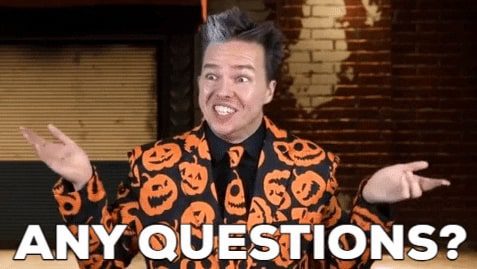
What is a GIF – and should you use GIFs in emails?
Developed by CompuServe back in 1987, a GIF, aka Graphics Interchange Format, is a noiseless animation created from videos or images and repeatedly playing every few seconds.
Back then, GIFs served to add movement to web pages. Today, they are an excellent method of online communication, as frequent as text messages. Millions of people send GIFs to each other in emails, messengers or social media to convey meanings that are challenging to express by words.
Long story short, a GIF is that very moment when “a picture is worth a thousand words.”
GIFs are funny and eye-catching. But this bare fact doesn’t necessarily make them relevant for email marketers. Before adding a GIF to an email, you have to think about its purpose there:
- Will it enhance a message or distract from it?
- Will it motivate customers to click or just make them smile? (Does it make sense to add a GIF for such an effect?)
- Is it appropriate for your brand voice and tone to communicate with your target audience using GIFs?
And if you see it’s worth trying, GIFs can benefit your email marketing campaign immensely.
Benefits of using GIFs in email marketing
For email marketers, a GIF is an instrument for grabbing extra interest from subscribers and increasing their engagement. And according to the 2018 survey by Litmus, the majority (78.8%) of marketers use animated GIFs (at least sometimes) in their campaigns.

When used appropriately, GIFs can provide many benefits to your email marketing campaigns:
- You can use them to demonstrate how your product works (That’s where the “Show, don’t tell” principle works, saving you from the need of writing long, descriptive texts most of the audience ignores in emails.)
- GIFs’ interactive nature helps you involve prospects in communication faster and more successfully than with stationary images.
- GIFs serve as an excellent replacement for videos, which is a great option for email clients that still don’t support embedded video content.
- Animated GIFs help you make messages more personal and fun, which is an excellent example of effective marketing.
- Adding relevant GIFs to emails can increase CTR and overall conversion of your email marketing campaign.
Case in point: Dell.
(I bet you’ve heard of this one! If not — feel free to shame me.)
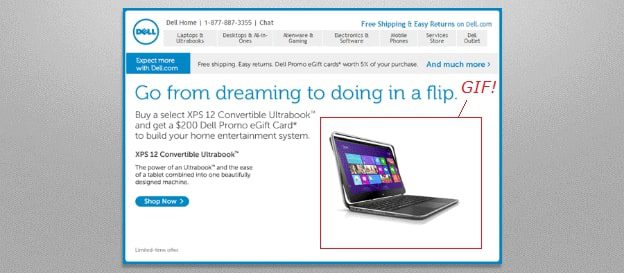
In 2014, their GIF-centric campaign brought a 6% increase in open rate, a 42% click rate, and a 103% increase in conversion rate. Impressive, right?
But what’s even more astounding is that it generated a 109% increase in revenue. “Guilty” for that success was a simple but elegant GIF in their emails announcing a new product.
The GIF highlighted a feature that would be challenging to explain and sell with words — a convertible screen. It demonstrated how a user could turn a laptop into a tablet in one movement. And that was the “wow” effect motivating them to click, learn more and, ultimately, buy.
To duplicate the success of Dell and other such-like campaigns, ensure you use GIFs in your marketing emails to accentuate your message.
Related: See what survey data tells us about animated marketing
How to use GIFs in emails
1) Define a goal of using GIFs in your email marketing campaign:
- Do you want to show your product in action?
- Is your plan to explain how a new feature of your product works? (Like how Dell did it.)
- Do you want to arouse curiosity in your audience?
- Is your plan to make your email outreach or sales pitch sound less cold, therefore winning a prospect’s favor?
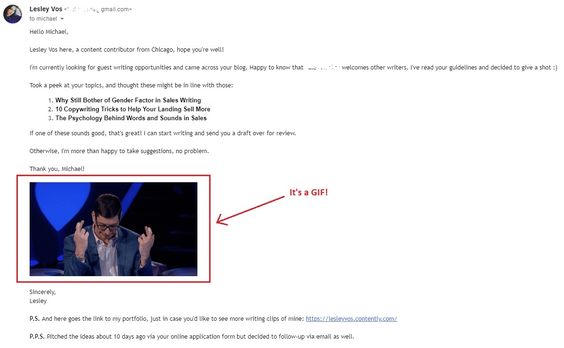
- Will your GIF work as a teaser for something new?
- Do you want to set the right mood in your email, like make the receiver smile or create FOMO (fear of missing out), for example?

2) Get a GIF that will be the most relevant to your particular goal.
Depending on that, you will either create your custom GIFs or choose animations from websites like GIPHY.
GIPHY is an excellent option to consider if you plan to entertain users, set the mood, or enhance the appeal of your emails. (Like I did in the above example of my outreach email.)
If you need a brand email showing your product or its feature in action, appealing to personalization, or demonstrating your brand’s authenticity, you’d better design GIFs yourself. In this case, here goes your next step.
3) Ask your designer to create brand GIFs for your email marketing campaign
Or try tools like Adobe or Cloud App to design them yourself. Make sure to optimize and save your animated GIFs properly.
Some optimization tips are:
- Don’t make GIFs too “heavy” and large. Given that your subscribers may have different internet speeds, your oversized animations can affect load time (people hate waiting!) or fail to display correctly. All of this will make emails less appealing.
- Keep mobile in mind. Many users open emails on their mobile devices today, and a large GIF can fail to load. Nothing frustrates subscribers more than getting a broken email from their favorite brand! Plus, your marketing voice won’t get heard, and all your endeavors will be in vain.
- Consider the animation speed. Some of your recipients may be visually impaired or be unable to perceive a GIF animation’s high speed. Please make it appropriate for comfortable observation.
For example, here’s an email from Charity: Water, a non-profit organization providing drinking water to people in need.
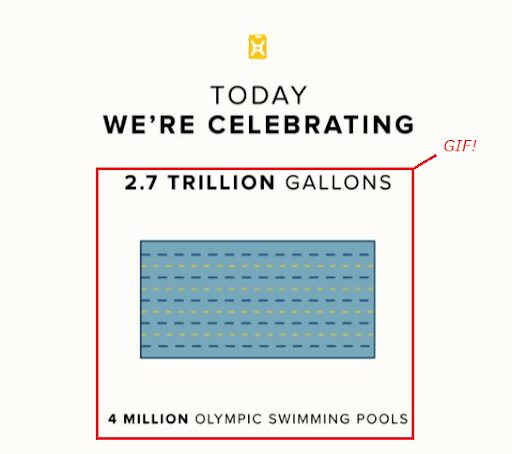
They use GIFs to share the achievement, but the animation speed is a bit high so some of us fail to read the accompanying text in due time. Wouldn’t it be more comfortable for the eye and less frustrating to the brain if the animation speed was slower?
What can go wrong with GIFs in email marketing?
As with any other marketing instrument, GIFs in emails can do both good and harm to your campaign. Here are some of the drawbacks.
1) Some email clients still don’t support GIFs.
Your subscribers may use Outlook 2007, 2010 and 2013, which won’t show the animation but just the first frame of your message. With that in mind, make sure this first frame includes the vital info of your message (an offer and a call to action). If a user doesn’t see your GIF, they’ll get your basic message anyway.
2) Your audience may consider GIFs unprofessional.
Indeed, not everyone enjoys GIFs or emojis in emails, especially if they don’t associate your serious brand with such “frivolity.” As a responsible email marketer, you need to know your target audience inside out and understand if your brand voice and tone allow for using informal communication with the audience.
Otherwise, they may view your GIF-ed emails as poor-quality content, which can tarnish your brand reputation and lower your email sender score.
3) Your GIFs load slowly.
As already mentioned, size-heavy and large GIFs affect load time and can fail to display correctly. Busy people won’t spend time waiting for your GIFs to download, so make sure to optimize them before inserting them into emails:
- Ensure the size is 0.5 MB or 1 MB maximum.
- Limit the number of colors and frames.
- Keep the width to 600px (that’s what a regular newsletter has).
4) Your GIF serves no purpose.
A meaningless GIF brings nothing but an adverse reaction from users. With no value, whether informative/educational or entertaining, this instrument becomes irrelevant and pointless to use in emails.
So, before adding a GIF to your email, ask yourself:
- Will it work in the email?
- Will it provide any value?
- Is it really worth sending?
If you see that your marketing message is clear without GIFs and you can send it without any animations, please do. GIFs aren’t a universal remedy, and they won’t save your email campaign if the content isn’t high quality or valuable.
Examples of brands using GIFs in emails brilliantly
That’s how Moo evokes curiosity and engages users in action. Coming with the subject line “Something sweet for you,” the brand targets its loyal audience:
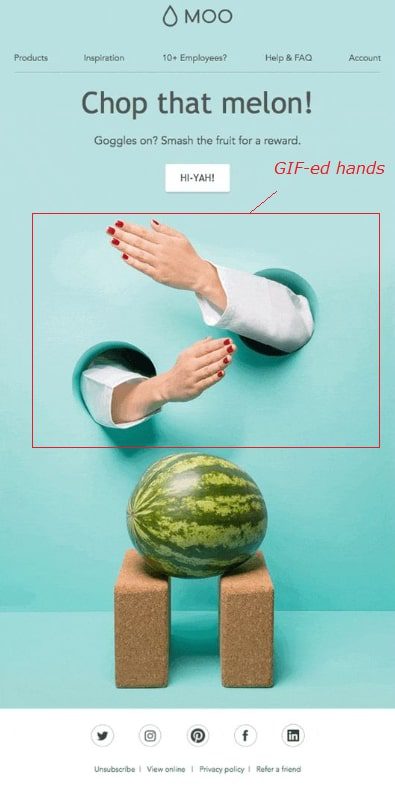
And here goes Loft, addressing FOMO and highlighting the text for more engagement:

What about Starbucks? They always set the right mood with their email communication, showing plenty of brand personality at the same time:

Takeaways: use GIFs in emails strategically
When you use them smartly, animated GIFs become an excellent conversion-boosting tool. They help grab the users’ attention, involve them in communication, demonstrate the UTP (unique trade proposition) of your product and motivate them to take your desired action.
Many brands use GIFs in email marketing with palpable growth in engagement and conversion rates. The trick is that they do in-depth research to make sure their audience will react positively. Also, they use GIFs with a purpose: to enhance their marketing message rather than distract users from it.
Author: Lesley Vos is a professional copywriter and guest contributor, currently blogging at edu platforms that help students and content creators with writing solutions. Specializing in data research, web text writing and content promotion, Lesley is in love with words, non-fiction literature and jazz. See more in Lesley’s portfolio.
Table of Contents
- What is a GIF – and should you use GIFs in emails?
- Benefits of using GIFs in email marketing
- How to use GIFs in emails
- 1) Define a goal of using GIFs in your email marketing campaign:
- 2) Get a GIF that will be the most relevant to your particular goal.
- 3) Ask your designer to create brand GIFs for your email marketing campaign
- What can go wrong with GIFs in email marketing?
- 1) Some email clients still don't support GIFs.
- 2) Your audience may consider GIFs unprofessional.
- 3) Your GIFs load slowly.
- 4) Your GIF serves no purpose.
- Examples of brands using GIFs in emails brilliantly
- Takeaways: use GIFs in emails strategically






